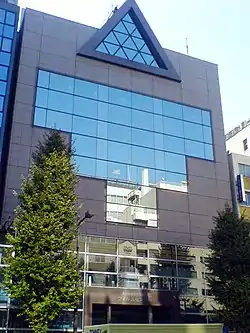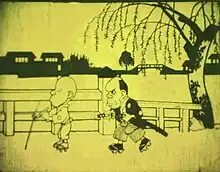National Film Archive of Japan
The National Film Archive of Japan (国立映画アーカイブ, Kokuritsu Eiga Ākaibu) is an independent administrative institution and one of Japan's seven national museums of art which specializes in preserving and exhibiting the film heritage of Japan. In its previous incarnation it was the National Film Center which was part of the National Museum of Modern Art, Tokyo. In April 2018 it became independent of the National Museum of Modern Art and was officially elevated to the rank of a national museum.[1][2]

The NFAJ is located in Kyōbashi, Tokyo and is Japan's only public institution devoted to cinema, holding about 40,000 films and numerous other materials in its collection. The Archive has film-related materials on permanent display and it holds special screenings in its theaters. The NFAJ is a member of The International Federation of Film Archives. It preserves many important works of Japanese and world film history including films designated as Important Cultural Properties of Japan like Momijigari.[3]
Collection

The NFAJ restored a Japanese animated film which had been first released in 1917—the oldest existing example of a Japanese animated film originally made for the cinema. The film, "The Blunt Samurai Sword" (Namakura-gatana), is the first work of Jun'ichi Kōuchi, one of the founders of Japanese animated film.[4] A rare surviving print was unexpectedly discovered in an antique market in Osaka. In the silent comedy the animation tells the story of a samurai warrior who is tricked into buying a dull-edged sword. He tries to attack passers-by in an effort to test the sword's quality but lower-class townspeople fight back and knock him down.[5] The animated story lasts just two minutes. Although the ultimate status of the film remains uncertain, it was screened by NFC for the public in late April 2008. With the involvement of the NFAJ the animated film became something more than an historical artifact—it also became an illustration of the progress film restoration has made over recent decades.[4]
The National Film Archive collection includes original movie scripts (such as Akira Kurosawa's Rashomon, Yasujirō Ozu's Tokyo Story and Kenji Mizoguchi's Osaka Elegy), original movie posters - Godzilla, Rashomon, Tokyo Story, The Life of Oharu etc. - photos shot on the set, movie cameras and actors and actresses' personal effects (such as Kinuyo Tanaka's).
Location
The NFAJ's Tokyo headquarters in the Kyōbashi building is a one-minute walk from Kyōbashi Station (Station G-10) on the Tokyo Metro Ginza Line. It is also a one-minute walk from Takarachō Station (Station A-12) on the Toei Asakusa Line. An NFAJ branch is located in the city of Sagamihara in neighboring Kanagawa Prefecture.
References
- "6館目の国立美術館 国立映画アーカイブがきょう誕生". 東京新聞 TOKYO Web (in Japanese). Retrieved 13 April 2018.
- "Founding of National Film Archive of Japan in April, 2018 | The National Museum of Modern Art, Tokyo". The National Museum of Modern Art, Tokyo. Retrieved 13 April 2018.
- "Hakkutsu sareta eigatachi 2009" (in Japanese). National Film Center, National Museum of Modern Art, Tokyo. Retrieved 10 December 2014.
- "Old anime discovered, restored," Daily Yomiuri Online. March 28, 2008.
- "Japan’s oldest animation films," ImprintTALK. March 31, 2008.